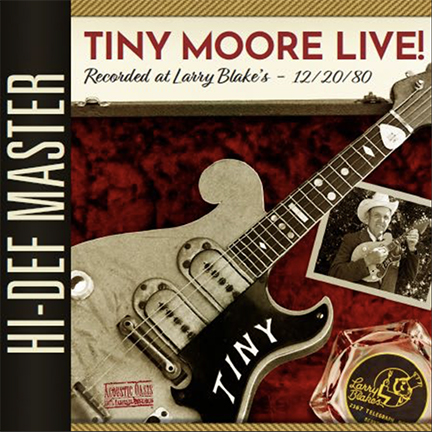
New Release: Tiny Moore Live! Recorded at Larry Blake’s — 12/20/80
I am excited to tell you about a new release of some old music that has inspired and excited me for over forty years. I recorded a live show of the great Tiny Moore playing electric mandolin and fiddle with a jazz band in 1980 and have had these recordings in my collection of old reel to reel tapes since then. Now, David Grisman’s Acoustic Disc label has released Tiny Moore Live!. How it all happened is an interesting tale that I thought I’d share with you.
About Tiny Moore
Tiny Moore is a legend among fans of western swing and country music. He is known primarily for his fluid and dynamic playing on the electric mandolin though he was also accomplished on the fiddle (his first instrument) and guitar. Tiny Moore found his early fame playing western swing mandolin and fiddle as one of Bob Wills’ Texas Playboys from 1946 to 1950. Wills made a habit of identifying each player as they soloed, whether during a live show or in the recording studio, and Tiny’s swinging and jazz-inflected improvisations are well-documented and identified on hundreds of Wills recordings.
Many casual listeners assumed that Tiny played some type of electric guitar, even though Wills would often identify Tiny’s mandolin and refer to it as the “biggest little instrument in the world.” Tiny always credited Charlie Christian, probably the first famous electric guitarist, as one of his major influences and even memorized some of the jazz guitar giant’s recorded solos. Christian’s approach to improvisation and his tone on the electric guitar surely impacted Tiny’s sound.
In 1970 Tiny began recording and performing with country singer Merle Haggard. He eventually joined Haggard’s band “The Strangers” full-time and stayed through the mid-1970s exposing his music to new generations of fans.
Most people who have heard of Tiny Moore probably know of him through his western swing work with Wills or his country playing with Haggard. On Tiny Moore Live at Larry Blake’s you’ll hear a lesser known though equally exciting and swinging side of this great musician. These recordings present Tiny in a small club with a jazz rhythm section — piano, bass, and drums — far from the western swing or country sounds you might expect. You’ll hear Tiny play melodies and trade solos on mandolin and fiddle with the other band members on “standards” from the Great American Songbook.
As far as I know, this is the only recording of Tiny playing an entire evening of jazz on pop standards, leading a live rhythm section, and switching off between electric mandolin and fiddle. His playing in this setting and style is a revelation and it swings mightily. Tiny played with incredible intensity and invention. His sound was filled with energy and life, expressing a range of emotions which always sounded joyful. His fingers danced effortlessly across the neck of his instruments, in, around, and through the melodies and chord progressions of these wonderful American classics.
Tiny covers one country song with the jazz band that looms large in his legend and that of American music: Bob Wills’ signature “Take Me Back to Tulsa.” Tiny sings the song in addition to playing solos on mandolin and fiddle. Though this is the only singing he does in this collection, Tiny was a fine singer and sang in most of the bands he played with throughout his career.
About the gig at Larry Blake’s
Tiny Moore Live! was recorded on December 20, 1980, at Larry Blake’s, a popular student restaurant and bar on Telegraph Avenue in Berkeley, a block or two from the University of California campus. Larry Blake’s restaurant was on the street level, the bar was in the dark and musty basement. At the time of this recording, Blake’s programmed a variety of rock and jazz acts, though this combination of Tiny Moore and local jazz players was a unique, one-time event. I was lucky to be at this gig and to record it, with Tiny’s permission.
Tiny met his fellow musicians, Dick Whittington (piano), Robb Fisher (bass), and Vince Lateano (drums) shortly before they began playing. There was no rehearsal though Tiny and Robb Fisher had discussed the types of tunes the band might perform. Tiny called the tunes and keys, one after the other, with a quick shout out to the band, “‘Georgia’ OK in F?” or “‘Mood Indigo,’ four flats?” and off they’d go improvising an instant arrangement with intros, solos, and endings.
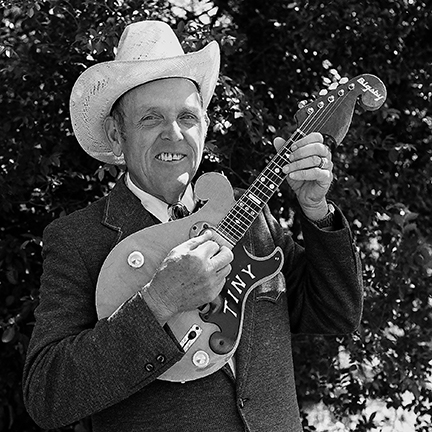
Tiny’s band mates were all well-known and popular players on the San Francisco Bay Area jazz scene. They worked constantly, together and in different bands, and they could usually be heard two or three times a week at different jazz clubs throughout the region. They were all stellar musicians who followed Tiny’s lead beautifully. It was exciting to see and hear the music coalesce spontaneously and with such ease and precision. All four were great players at the height of their skills as individual musicians and band members.
December 20, 1980 was a relatively slow, foggy Saturday night. Most of the students had already left for the Christmas break. The crowd was not large, particularly at the beginning of the night, with a few scattered fans here and there. Some might have been familiar with one or more of the musicians, but mostly it was a small group of people out for a beer and whatever music might be playing in the background. Tiny and the band played three full sets of music plus a fourth two-song set at the end of the evening.
About the Recording
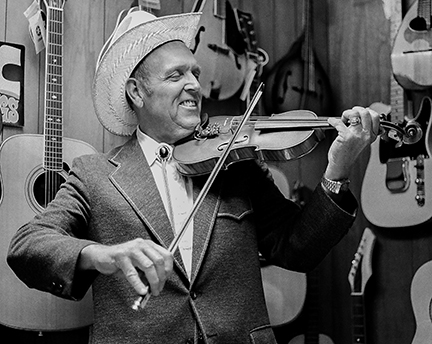
I met Tiny Moore at a fiddle contest in Northern California in early 1978 and interviewed him a few weeks later at his store, Tiny Moore Music, in Sacramento, CA. The interview was for a small magazine called Mandolin World News that had been started two years earlier by David Grisman and members of his quintet.
I kept in touch with Tiny after the interview, went to hear him play frequently, and he became a friend and mentor. I sat in on many lessons Tiny gave to my good friend and band mate John Gonder who also played electric mandolin. I came along to play chords on the guitar and learned a great deal about songs and soloing by hearing them trade licks. John devoted himself to Tiny’s music and became the most accomplished aficionado of Tiny’s approach on five-string electric mandolins that John himself built.
In late 1980 Tiny told me about his upcoming gig with a jazz band at Larry Blake’s. I’d never heard Tiny in a strictly “jazz” context, so the prospect was exciting. I’d just bought a second hand, four track, reel-to-reel Akai tape recorder and TEAC mixer. I asked Tiny if he’d let me try it out and record the show and he agreed.
On the night of December 20, 1980, my friend John Gonder helped me haul that huge and heavy tape recorder, mixer, various microphones, stands, cords, headphones, probably the tape recorder manual, down the long flight of stairs into Larry Blake’s subterranean bar. We commandeered a bit of space off to one side of the bandstand and started setting up. This was the first time I’d used the equipment to record a show and the machinery was still a mystery to me. I remember being somewhat puzzled as to how to correctly route the microphones first into the TEAC mixer and then into the recorder. I did something wrong and all the microphones went mono into all four recorder channels. We ended up with four track mono, no separation, no possibility of mixing. After a few songs we figured out how to assign the microphone signals to specific tape recorder tracks.
Throughout that first set we adjusted volumes and generally tweaked the equipment. I had expected that it would take us a set or so to settle in and it did. The quality of the recordings improved as the evening progressed and we figured out how the mixer and tape recorder worked.
We recorded a lot of music that night: three full sets plus two songs from the short fourth set at the end of the night. (The third and fourth sets are combined on this release.) All through the show Tiny switched between his custom Bigsby five-string electric mandolin and his fiddle while trading solos and “fours” with the other players. It turned out to be one of the most exciting nights of music I have ever witnessed.
As I listened to the recordings in the days following the show, I realized what a treasure they were. I listened to the tapes again and again trying to absorb as much of them as I could. I transcribed several of Tiny’s solos. I made copies for Tiny, John Gonder and other friends and kept cassette copies in my car and listened to them continually. I stored the original 7 inch reel to reel tapes on a variety of book cases and in cardboard boxes, in garages and basements as I moved to different apartments and houses. Whenever I’d move, they’d move with me to different corners and closets.
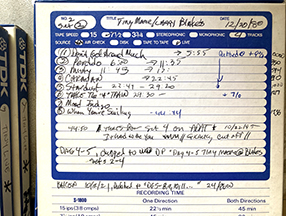
When it became possible to transfer these analog originals to ADAT tape, I did that. When it became possible to mix these to CD, I did that also. I tried to preserve them as carefully as I knew how and always had it in the back of my mind that these recordings should be released some day so that more people could hear this aspect of the genius of Tiny Moore.
In the Spring of 2021, with time on my hands due to the pandemic shutdown, I started a project to listen to, catalog, and digitize all the tapes in my collection, some made as far back as the early 1970s. I wanted to find out which had survived the ravages of time and would still play. I hoped to be able to restore any tapes that wouldn’t.
One of the first sets of tapes I worked with was the Tiny Moore Live! set. Tape number one, which contained the music of the first set of the Larry Blake’s performance, wouldn’t play! It was affected with what’s known as “sticky shed syndrome.” The tape would audibly squeal on the tape heads and leave gummy deposits of oxide that needed to be cleaned every minute or so. The music sounded muffled and tended to slow down as it played. The tape was decomposing before my eyes. The only hope for a cure was to bake the stricken tape and hope that the oxide emulsion might be “baked” back onto the tape itself.
I loaded all the Tiny Moore Live tapes into my specially modified food dehydrator and heated them for about four hours at 140° F. Miraculously the remedy worked and the tapes played well enough to digitize the contents into 9600 K 24 bit audio files. This treatment usually makes the tapes playable for a couple of weeks and then they revert to their “sticky shed syndrome” state.
The sound on the original tapes was quite high in resolution and the whole tonal spectrum seemed to have been preserved. There was a depth to the sound that hadn’t been present on the cassette dubs. The music sounded like it was played by live musicians, on real instruments, in a real club, two days ago.
As I re-mixed the four track tapes, I noticed many things that I’d either forgotten or hadn’t noticed before. For example, the band played two versions of “Exactly Like You,” one in Set One and the other in the very abbreviated Set Four. The first version is a bit more relaxed than the second but both of them kick! Right before the last chorus of the first “Exactly Like You” Tiny can be heard saying to the band “Fours?” Fours?” to set up a section of “trading fours” where each player plays four measures and then passes the soloing on to the next player for four measures.
I hadn’t realized previously how many Duke Ellington songs Tiny played that night. In addition to “Don’t Get Around Much Anymore” there was “Caravan,” “Satin Doll,” “C Jam Blues,” “Perdido,” “Take the A Train,” and “Mood Indigo,” five of them featured in set two alone. I guess Tiny liked Duke.
At a couple points in the show Tiny used an effects foot pedal, a phase shifter, to change the sound of his mandolin. These “stomp boxes” were all the rage for electric musicians at that time. They’re still widely used. Tiny sold instruments and other musical equipment out of his Sacramento store. Often he’d try out new pieces of equipment and instruments on his gigs and I don’t remember seeing him play through the same amplifier twice. At Larry Blake’s he tried the phase shifter. You can hear it acting up a bit on “My Blue Heaven.” He eventually unplugged it and went straight into his amp. Later he brought it back and featured it on “Don’t Get Around Much Anymore.” I assume he was doing a little market research, trying it out so he could explain its use it to an interested customer.
It was wonderful to re-visit these recordings again in their original state, and I decided it was finally time to make them available to the public. There was no question that David Grisman would be the first person I would contact about this. He was friends with Tiny, loved his music, and had already produced an LP with Tiny and Jethro Burns in the late 1970s. Back to Back brought Tiny together with the celebrated mandolinist and comedian Jethro Burns (of the comedy/music duo Homer and Jethro), guitarist Eldon Shamblin (also from Bob Wills’ Texas Playboys) and jazz masters Ray Brown on bass and Shelly Manne on drums. Back to Back is a potpourri of classic and newer jazz and pop standards, original compositions by each mandolinist, a bit of western swing, and even a bluegrass tune. The pop standards on Back to Back offer us a brief and rare recorded peek into the world of Tiny’s — not to mention Jethro’s –improvising on mandolin in a jazz context. Back to Back serves as a preview to Tiny Moore Live!
When I sent these restored recordings to David Grisman he was thrilled with the music and immediately expressed his interest in producing and releasing them. He made it happen!
When I think about the journey these recordings have taken in over forty years I’m amazed that they got recorded in the first place, that the music was played so wonderfully, that the recordings survived, that they were revived, and that we are able to listen to the music they contain today. A lot of luck was involved and the final package that you can hear today happened because of David Grisman’s interest and his amazing producing skills. Thank you David!
This projecrt began as an unusual one-off show on a slow Saturday night in late December. It hadn’t happened before and would never happen again. Thankfully the pieces have all fallen into place and the rare music that Tiny Moore, Dick Whittington, Robb Fisher, and Vince Lateano made that night so long ago has endured and is available for you to hear, enjoy, and inspire. I think you’ll enjoy and love this music as much as I do!
More on Tiny Moore
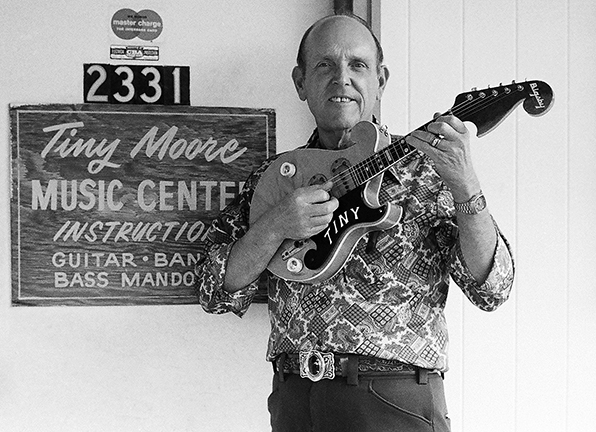
Billie Mack “Tiny” Moore was born in Port Arthur, Texas, on May 12, 1920. He began taking classical violin lessons at about age six. His mother taught piano occasionally, and the two would play popular tunes of the day by reading sheet music. Unfortunately, his violin teacher found out about this recreational playing and was not happy, directing him to stop playing popular songs.
He continued his classical training for three or four more years and then stopped playing the violin until his mid-teens. By that time he had overcome the numbing influence of his strictly classical training and began playing popular tunes on fiddle with friends and relatives at house parties and dances. When he heard an electric mandolin played by Leo Raley on the radio, Tiny’s interests quickly shifted from violin to mandolin and he began playing an electricified eight-string Gibson mandolin. Around this same time he began playing mandolin and fiddle in a succession of bands that took him throughout Texas, Louisiana, Oklahoma, and many parts of the southern United States.
After service in World War II Tiny landed a job with Bob Wills and His Texas Playboys in 1946 that lasted for four years. In 1950 Tiny traded a life on the road with Wills to manage Bob Wills’ Sacramento recreation venue, Wills Point. He continued playing in the Wills Point house band, fronted by Bob’s younger brother, Billy Jack Wills.
The 1950s brought television, rock and roll, and hard times to the Wills organization. As Wills’ businesses struggled to survive, Tiny began working as a jack-of-all-trades at a local television station. Eventually he hosted a popular children’s show, Ranger Roy and the Anna Banana Show, that lasted until 1960 when a labor dispute led to a strike at the television station.
Tiny’s playing at this time was generally confined to local work on weekends. When his television job ended he began teaching guitar, fiddle, and mandolin. He eventually opened Tiny Moore Music in 1962 and continued playing music locally.
In 1970, Tiny was contacted by Merle Haggard to help record, along with other Wills alumni, an album entitled A Tribute to the Best Damn Fiddler in the World. This led to a continuing association with Haggard, as both a recording and performing artist. Tiny joined Haggard’s band The Strangers full-time in 1973 and stayed for three years.
It was fascinating to talk with Tiny about his life in music and his philosophies of music and of teaching when I interviewed in him in 1978. I asked him about playing jazz. He told me that he didn’t think of “jazz” as a particular style or repertoire. Rather, he thought of it as the process of improvisation. “You didn’t call it jazz,” he told me. “We would call it ‘take off.’ … You’d play the melody maybe one time through, then you’d…(be) playing jazz, but we would call it ‘taking a chorus,’ or playing a ‘take off.’”
Tiny told me that he thought of songs like “How High the Moon” or “Exactly Like You” as “pop” songs and not “jazz” songs. These were songs that he’d heard on the radio in the 1920s and 1930s. Together they formed the repertoire of compositions that jazz musicians still use when they improvise.
Those bits of information make perfect sense to me now but at the time they were revelatory. I’d thought of jazz as a style of music, maybe a repertoire of songs, not the process of improvisation on a composed melody and set of chord changes.
Tiny shared many other nuggets of wisdom in the course of the interview that have influenced me in the intervening years. I feel very fortunate to have heard his thoughts, lessons that he’d learned along the way, and especially his insights on playing music.
I asked him about his teaching philosophy and how he would teach a student about jazz or improvising. “I try to guide them roughly like this: music is nothing in the world but a combination of scales and chords. If I want to deviate from the melody … and put in a few little extra things, there are a few rules that I know I have to go by. 1) I must know the chord I’m on. 2) I need to start a passage with one of the notes of that chord. I also need to end that passage with one of those notes. If it happens to be a seventh chord I think it should have several flatted notes in there … To me these are the basic rules of playing hokum, jazz, or whatever…That’s the only way I know to do it.”
Tiny Moore died on December 15, 1987, onstage with a band in Jackpot, NV, almost exactly seven years after the Larry Blake’s recordings were made.
I’m so lucky to have met Tiny Moore in 1978 and to have been able to talk to him about his life and music. Hearing him play over the years has been a gift. I’ve enjoyed listening to these live tapes many, many times, always hearing and learning new things. I’m delighted that they’re now available to music lovers throughout the world!
—Dix Bruce Spring 2022
Click here to purchase and download Tiny Moore Live!
Click here for a video version of this blog including sample songs and 16 rare and historic photos of Tiny Moore.
Videos of Tiny Moore
There are a few videos of Tiny Moore currently available on the web. One of the best shows Tiny being interviewed, and playing mandolin and fiddle: https://www.youtube.com/watch?v=s7un0syAM78.
This video shows Tiny with David Grisman, Jethro Burns, and Johnny Gimble on Austin City limits: https://www.youtube.com/watch?v=VOMkcKdClK0
Here’s Tiny with Eldon Shamblin singing with Merle Haggard and The Strangers: https://www.youtube.com/watch?v=B1x8tVhUQVE
These two videos show Tiny at the National Oldtime Fiddlers’ Contest and Festival in Weiser, Idaho, in the summer of 1987 https://www.youtube.com/watch?v=Se9kb6dsHLQ
https://www.youtube.com/watch?v=utI3S3IFZT0
Here’s Tiny on a Billy Jack Wills radio show:
https://www.youtube.com/watch?v=eiKuKXd78ss
Dix Bruce interview about Tiny Moore Live! with Hayes Griffin:
https://www.youtube.com/watch?v=gnLQ7O0jI38
Dix Bruce interview about Tiny Moore Live! with Scott Wikle, Host & Program Director
My Kind Of Country
www.fishcreekradio.com
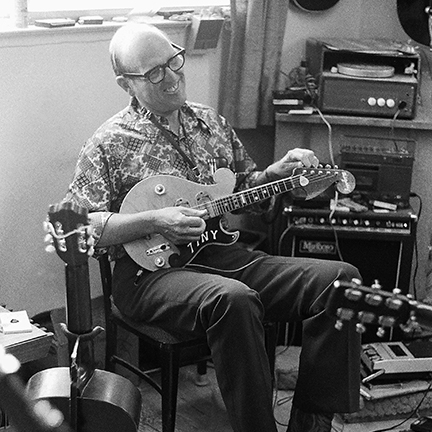
Tiny Moore plays David Grisman’s Gibson F-5 “Fern” mandolin.
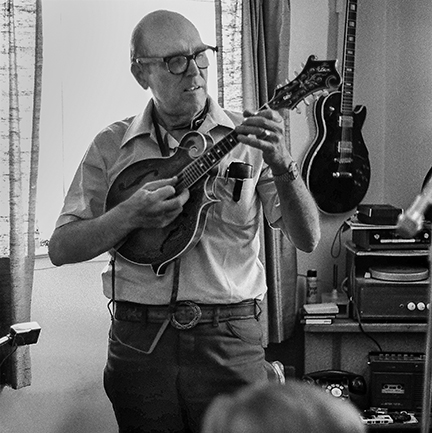
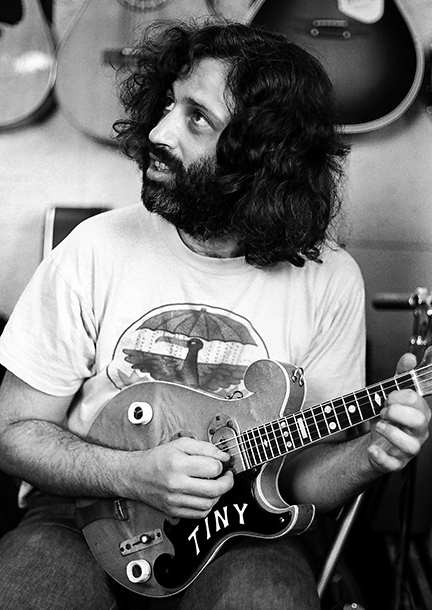
David Grisman plays Tiny Moore Bigsby electric 5-string mandolin.
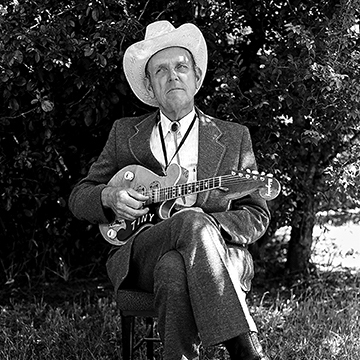
Photos of Tiny Moore, Sacramento, CA, Spring 1978 © 2022 by Dix Bruce